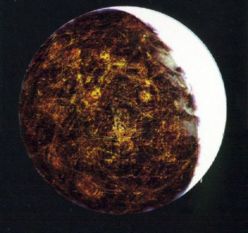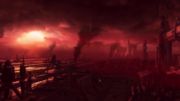Difference between revisions of "Coruscant"
From TheHolo.Net Forums Wiki
| Line 27: | Line 27: | ||
[[Image:Coruscant at night.jpg|thumb|left|Overlooking the Senate District at night, c. 19 BBY.]]The entire surface of Coruscant was covered over throughout the thousands of generations of galactic history by sprawling mile-high skyscrapers and cities, and boasting a population of over a hundred billion to several trillion, depending on the era. These skyscrapers dwarfed all the original natural features, including mountains, as well as floors of oceans which once covered a large proportion of Coruscant's surface. Areas of Galactic City were broken up into levels, megablocks, blocks, and subblocks. Coruscant itself was divided into quadrants, which were divided into zones. Below the skyscrapers was Coruscant's Underworld/undercity, where sunlight never reached. Artificial lighting illuminated these lower levels and advertisement holograms could be seen everywhere. There were numerous establishments for entertainment, catering to a myriad of alien species. | [[Image:Coruscant at night.jpg|thumb|left|Overlooking the Senate District at night, c. 19 BBY.]]The entire surface of Coruscant was covered over throughout the thousands of generations of galactic history by sprawling mile-high skyscrapers and cities, and boasting a population of over a hundred billion to several trillion, depending on the era. These skyscrapers dwarfed all the original natural features, including mountains, as well as floors of oceans which once covered a large proportion of Coruscant's surface. Areas of Galactic City were broken up into levels, megablocks, blocks, and subblocks. Coruscant itself was divided into quadrants, which were divided into zones. Below the skyscrapers was Coruscant's Underworld/undercity, where sunlight never reached. Artificial lighting illuminated these lower levels and advertisement holograms could be seen everywhere. There were numerous establishments for entertainment, catering to a myriad of alien species. | ||
| + | |||
| + | '''Water''' | ||
| + | |||
| + | Coruscant was once a world mostly covered in oceans. However, all natural bodies of water were drained and stored in vast caverns beneath the city as a result of years of overpopulation. The only body of water visible was the artificial Western Sea, with many artificially-created islands floating on it, used by tourists on holidays. | ||
| + | |||
| + | With no bodies of water available to feed and water its trillion inhabitants, Coruscant's architects, along with many others from around the galaxy, worked together to build a self-contained eco-system in the massive buildings set all over the planet. Polar cap stations also melted ice and distributed water throughout the planetwide city through a complex series of pipes. | ||
| + | |||
| + | '''Mountains''' | ||
| + | |||
| + | One of the few pieces of Coruscant's landmass that were left untouched were the '''Manarai Mountains''', twin peaks that stuck up out of the ground near the famous Imperial Palace. The Manarai Mountains included the tallest peak, Umate; many floating restaurants; the Monument Plaza; and were home to the ''Flames of Umate'' cult. | ||
| + | |- | ||
| + | ! class="nounderlinelink mp2righttitle" style="font-size:120%; border-width: 1px; border:1px solid #CDB79E;background:#CDB79E;-moz-border-radius:10px;padding:6px 6px 6px 6px;" | | ||
| + | <center>'''Neighborhoods''' </center> | ||
| + | |- | ||
| + | |Galactic City was divided into quadrants, "several thousand" in number, with each quadrant further split into sectors. Each sector was numbered on official maps, but sectors often had nicknames, such as '''Sah'c Town''' (sector H-46, named for a prominent family that owned a large portion of its land) and '''The Works''', the largest of Coruscant's designated industrial zones. | ||
| + | |||
| + | Coruscant practiced zoning, which is the designation of specific areas of land for particular purposes, such as governmental and senatorial, financial (including banking zones), residential, commercial, industrial, and manufacturing. Manufacturing and industrial zones were typically the largest designated areas of the planet. | ||
| + | |||
| + | [[Image:Theworks view.jpg|thumb|right|The Works landscape.]] | ||
| + | The Works was once one of the Galaxy's major manufacturing areas, where spacecraft parts, droids, and building materials were heavily produced for centuries, but as construction and industry became more efficient and cheaper away from Coruscant, The Works fell in disrepair. It gained the reputation as a hub of high criminal activity and many locals stayed away from it. | ||
| + | |||
| + | Another area of Coruscant was '''CoCo Town''' (short for "collective commerce"). Many diverse species lived there and worked in manufacturing. A partially enclosed open-air plaza near the Senate building was called Column Commons because it housed most of the HoloNet and news media corporations. | ||
| + | |||
| + | Most infamous of all was the '''Alien Protection Zone''', colloquially known as the Invisible Sector''' or '''Invisec''' for short, was a walled off ethnic neighborhood on Imperial Center. A neighborhood supposedly built for non-Human species to protect them from "genuine prejudice", the Galactic Empire was in essence segregating them from the human population. This practice is in line with the Empire's undeniable Humanocentric policies. | ||
| + | |||
| + | Conditions inside Invisec were very poor and residents were often harassed by Stormtroopers. Propaganda reports indicate that neighborhoods were built to reflect the various different cultures of the galaxy's alien species, though this may have been untrue. However, it is true that alien neighborhoods were dominated by statues to honor heroes from their respective homeworlds. This tactic was used to make alien residents feel as if the ethnic neighborhoods were really meant to be a place of honor and hope, which they were not. | ||
| + | |- | ||
| + | ! class="nounderlinelink mp2righttitle" style="font-size:120%; border-width: 1px; border:1px solid #CDB79E;background:#CDB79E;-moz-border-radius:10px;padding:6px 6px 6px 6px;" | | ||
| + | <center>'''Livability''' </center> | ||
| + | |- | ||
| + | |Coruscant orbited relatively far from its tiny star Coruscant Prime, ranging from 207 million to 251 million km. Thus, Coruscant did not naturally have a climate suitable for Humans. Coruscant's Humans countered this by erecting a series of Orbital Solar Energy Transfer Satellites that reflected the sun's warmth and light. Several of these mirrors would be destroyed in the Battle of Coruscant during the Clone Wars, although it is unknown whether this had any lasting effect. It is known that thunderstorms and rain occurred during 19 BBY, possibly as an effect of the altered sunlight from the remaining mirrors. | ||
| + | |||
| + | Almost everything on the planet, from clothes to packaging and machinery, was recyclable. Another problem for a world like Coruscant was the unimaginable amount of carbon dioxide and heat energy that its trillion-being population generated each day, so thousands of carbon dioxide-reactive atmospheric dampeners were put into place in the upper atmosphere to prevent atmospheric degeneration. The first set of these planet-wide dampeners, developed by the Galactic Republic, was known as the Coruscant Atmospheric Reclamation Project. | ||
| + | |||
| + | Near the planet's core were a number of massive power relay stations. The lowest levels were abandoned to mutants and scavengers, such as the cannibalistic, mythical Cthons. The foundations of many of the buildings, some of which weighed billions of tons, also extended deep into the planet's crust. | ||
| + | |||
| + | Galactic Standard Time was developed on Coruscant and revolved around the hours Coruscant had in a single day, which was 24 hours, with 368 local days a year. | ||
| + | |- | ||
| + | ! class="nounderlinelink mp2righttitle" style="font-size:120%; border-width: 1px; border:1px solid #CDB79E;background:#CDB79E;-moz-border-radius:10px;padding:6px 6px 6px 6px;" | | ||
| + | <center>'''Economy''' </center> | ||
| + | |- | ||
| + | | | ||
|- | |- | ||
! class="nounderlinelink mp2righttitle" style="font-size:120%; border-width: 1px; border:1px solid #CDB79E;background:#CDB79E;-moz-border-radius:10px;padding:6px 6px 6px 6px;" | | ! class="nounderlinelink mp2righttitle" style="font-size:120%; border-width: 1px; border:1px solid #CDB79E;background:#CDB79E;-moz-border-radius:10px;padding:6px 6px 6px 6px;" | | ||
Revision as of 23:31, 18 March 2008
The Galactic Center of Coruscant (pronounced /'kʊɹəsɑnt/) was the political hub of the galaxy for millennia. It was generally agreed that Coruscant was, during most of Galactic history, the most politically important world in the galaxy. A large number of the galaxy's trade routes—including the Perlemian Trade Route, the Corellian Run, the Metellos Trade Route, the Koros Trunk Line, and the Leisure Corridor—went through Coruscant, making it one of the richest worlds in the galaxy. Tellingly, the planet's hyperspace coordinates were (0,0,0), and the military designation was Triple Zero.
The actual planet-wide city of Coruscant was known as Galactic City, Republic City, Coruscant City or the City of Spires under the Galactic Republic and as Imperial City during the rule of the Galactic Empire.
|




